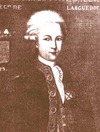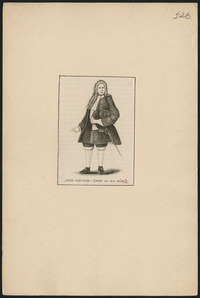SCHUYLER, PETER, soldier, government official, and the most influential Indian expert in New York province during his day; b. 17 Sept. 1657 (o.s.) in Beverswyck (Albany, N.Y.), second son of Philip Pieterse Schuyler, an emigrant from Amsterdam, and his wife Margarita Van Slichtenhorst; married twice: first to Engeltie Van Schaick in 1681 or 1682, and secondly, in 1691, to Maria Van Rensselaer, daughter of Jeremiah Van Rensselaer; d. 19 Feb. 1723/24.
Albany was the northernmost settlement of any size in New York province. Two hundred miles almost due north lay Montreal. Though separated by impenetrable wilderness, the two settlements were joined by an almost continuous waterway consisting of the Richelieu River, Lake Champlain, Lac Saint-Sacrement (Lake George), and the Hudson River. The French claimed all the territory whose waters found an outlet in the northern lakes and the St Lawrence, by right of discovery and occupancy. It included Lake Champlain. The English resisted the claim and asserted their right to the country as far north as the St Lawrence, through a title derived from the Five Nations. During a long period of almost continuous warfare, the Iroquois sided mostly with the English, partly because Albany was nearer their homeland and easier to trade with, and partly because of the great skill of Peter Schuyler in dealing with them.
Schuyler had important family connections at Albany. Both his mother and his second wife were daughters of directors of Rensselaerwyck, one of the founding Dutch settlements in the Albany area. When Albany was incorporated as a city in 1686, Peter Schuyler became its first mayor and ex officio chairman of the board of commissioners for Indian affairs. During the next several years there were raids and massacres at Lachine near Montreal, at Schenectady near Albany, and elsewhere within the disputed borderlands. In 1690 Peter Schuyler, hearing that a French delegation was treating with the Iroquois, led an English delegation to Onondaga (Syracuse, N.Y.), the Iroquois capital. The French were captured and some were killed, but at least one, the Chevalier d’Aux (Eau) – a half-pay captain who had been sent as an emissary to the Iroquois by Buade* de Frontenac, governor of Canada – was taken back to Albany by Schuyler. The Iroquois called Schuyler “Quider” (their pronunciation of Peter), and according to Parkman an Onondaga sachem declaimed: “Brethren . . . we must hold fast to our brother Quider, and look on Onontio [Frontenac] as our enemy. . . .” That same year an English expedition against Canada was assembled at Albany and placed under the command of Major-General Fitz-John Winthrop. Peter Schuyler collected a few Mohawk warriors and proceeded to Wood Creek, at the southern end of Lake Champlain, where he engaged in making bark canoes for the use of the army. Since there were not enough canoes or supplies, General Winthrop abandoned the expedition.
The following year (1691), a rumour reached the English that Frontenac had received reinforcements and supplies from France and was concentrating troops at Montreal, preparatory to a descent on Albany. In order to gain intelligence, Major Peter Schuyler led northward, in July, a party consisting of 120 white men, 80 Mohawks, and 66 River Indians (Schaghticokes). At the confluence of Lac Saint-Sacrement and Lake Champlain, called Ticonderoga, Schuyler was joined by an additional contingent of Mohawks, and the expedition proceeded down Lake Champlain and the Richelieu River until it was within ten miles of Fort Chambly, which was commanded by Jean-Vincent Le Ber Du Chesne. Scouts from the fort notified the Chevalier de Callière, the governor of Montreal, who collected from 700 to 800 men and encamped at La Prairie de la Magdeleine on the south shore of the St Lawrence, opposite Montreal. He then sent out several scouting parties, and a few days later one of the sons of Joseph-François Hertel de La Fresnière brought in word that he had seen a canoe containing Mohawks in the Richelieu River. Thinking that Chambly was in danger, the governor of Montreal sent Philippe Clément Du Vuault de Valrennes to the spot with about 200 men. Nicolas Daneau de Muy and Claude Guillouet d’Orvilliers were in the company.
Meanwhile, Schuyler, leaving his canoes on the river-bank, had made his way overland to La Prairie de la Magdeleine, reaching that fort on the rainy night of 31 July (10 August, N.s.). An hour before daybreak on 1 August (11 August) the sentinel at the fort fired his piece and M. de Saint-Cyrque (Sircq), an old captain commanding in the absence of Callière who was ill and confined to his bed in the fort, led an advance. A musket volley mortally wounded him and the Sieur d’Escairac (Desquerac), and killed M. d’Hosta (Dosta) on the spot. The second wave of troops led by Jean Bouillet de La Chassaigne came up at that moment and rushed headlong on the enemy who, after a vigorous resistance, retreated in good order. Another small French detachment, led by the Sieur Domerque, attacked Schuyler’s retreating forces and was wiped out. Schuyler now headed for his canoes on the Richelieu River but was intercepted by the party sent out to protect Fort Chambly. Valrennes and Le Ber deployed their men behind trees and fought the English for an hour and a half. Schuyler finally succeeded in cutting his way through the enemy and reached his canoes. As he reported to the provincial council in New York a few weeks later, “We took our march homewards and found 5 Elks in the way which refreshed our whole company. . . . We lost in the expedition 21 Christians 16 Mohaques 6 River Indians & the wounded in all 25. . . . Thought to have killed about 200 French and Indians.” The bravery and competence shown by Schuyler’s expedition made a favourable impression on the Indians of the Five Nations, who were now convinced that the English could fight and were willing to risk their lives in the war.
During the winter of 1692–93 Frontenac sent southward an expedition, commanded by Lieutenants Nicolas d’Ailleboust de Manthet, Augustin Le Gardeur de Courtemanche and Robutel de La Noue, which destroyed three Mohawk villages and captured many women and children. Schuyler led a party which pursued the retreating French and forced them to relinquish most of their prisoners.
When peace was concluded between England and France, the Earl of Bellomont, governor of New York, sent Schuyler and the Reverend Godfrey Dellius to Quebec in May l 698 to deliver news of the peace to Count Frontenac, and also to return all French prisoners held in New York. This was Schuyler’s last expedition to Canada.
Schuyler was made a lieutenant of Francis Nicholson for the proposed expeditions against Canada in 1709 and 1711. Their forces were to attack by way of Lake Champlain. In both cases, however, the forces never got beyond the Lake Champlain camping grounds. Early in 1710, Schuyler took four Mohawk sachems to London where they were received by Queen Anne. His aim was to emphasize the importance of retaining the friendship of the Five Nations.
Schuyler continued throughout his life to serve as Indian commissioner and as a member of the provincial council. He was acting governor of New York from July 1719 to September 1720. He was dismissed from the council by the new governor, William Burnet, but continued at the head of the Indian board until his death in 1724.
Calendar of council minutes, 1668–1783 (N.Y. State Lib., Bull. LVIII, Hist. VI, Albany, 1902). Charlevoix, History (Shea). Coll. de manuscrits relatifs à la N.-F., I, 586–88. “Correspondance de Frontenac (1689–99),” APQ Rapport, 1927–28, 70; 1928–29, 370–71. “Correspondance de Vaudreuil,” APQ Rapport, 1947–48, 161–66. NYCD (O’Callaghan and Fernow), III–VII, IX (see Index). PRO, CSP, Col., 1685–88, 1689–92, 1710–11, 1711–12. Walker expedition (Graham). DAB. R. P. Bond, Queen Anne’s American kings (Oxford, 1952). Eccles, Frontenac. Parkman, Count Frontenac and New France (1891), 198. G. W. Schuyler Colonial New York; Philip Schuyler and his family (2v., New York, 1885). Waller, Samuel Vetch. A. J. Weise, The history of the city of Albany, New York (Albany, 1884).
© 1969–2024 University of Toronto/Université Laval
Image Gallery

Cite This Article
John H. G. Pell, “SCHUYLER, PETER (1657-1723/24),” in Dictionary of Canadian Biography, vol. 2, University of Toronto/Université Laval, 2003–, accessed April 26, 2024, http://www.biographi.ca/en/bio/schuyler_peter_1657_1723_24_2E.html.
The citation above shows the format for footnotes and endnotes according to the Chicago manual of style (16th edition). Information to be used in other citation formats:
| Permalink: | http://www.biographi.ca/en/bio/schuyler_peter_1657_1723_24_2E.html |
| Author of Article: | John H. G. Pell |
| Title of Article: | SCHUYLER, PETER (1657-1723/24) |
| Publication Name: | Dictionary of Canadian Biography, vol. 2 |
| Publisher: | University of Toronto/Université Laval |
| Year of publication: | 1969 |
| Year of revision: | 1982 |
| Access Date: | April 26, 2024 |












